By Steven A. Tjosvold
Now through the spring is the time to take a close look at crops that are susceptible to downy mildew so that the disease can be detected early. This post follows the previous one that describes the general identification and biology of downy mildew diseases. Here are some more images illustrating the symptoms on various ornamental crops.
Downy mildew on impatiens caused by Plasmopara obducens affects all Impatiens walleriana hybrids, but does not affect New Guinea impatiens. (LEFT) Symptoms of impatiens downy mildew often first occur on leaves near the tips of branches. At first, the top of leaves can develop an irregular yellow-green or purple discoloration. Affected leaves often curl downwards. Infected plants are often stunted. Leaves and flowers can eventually drop off, leaving a bare stem. The pathogen in wet and cool
Downy mildew on impatiens can lead to severe defoliation and death
Downy mildew on impatiens can lead to severe defoliation and death
conditions can sporulate profusely producing a fuzzy white mass on the under sides of leaves, stems and flower buds.
Possibly the first indication of downy mildew on impatiens
Downy mildew sporulation on undersides of leaves and buds (circled)
Downy mildew on impatiens can lead to severe defoliation and death
Downy mildew on statice grown for cut flowers in field
Downy mildew on statice
Sporulation of downy mildew on statice
Downy mildew on delphinium (Delphinium species and cultivars) caused by Peronospora ficariae. (BELOW) Initial symptoms on leaves consist of light green patches. These areas quickly turn dark green to blackish green and often delimited by the central vein of the leaf. Purple-gray sporulation of the pathogen seen primarily on the underside of leaves. Symptoms are most severe on older foliage. As disease progresses, the lower leaves wither and dry up, giving the plant a blighted appearance.

Downy mildew on Delphinium
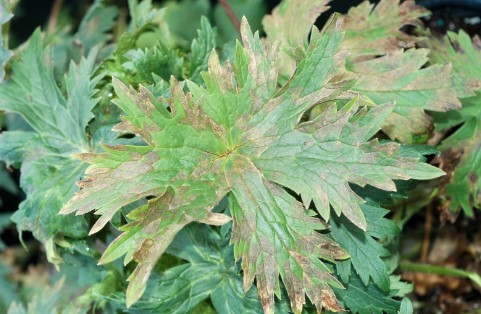
Downy mildew on Delphinium
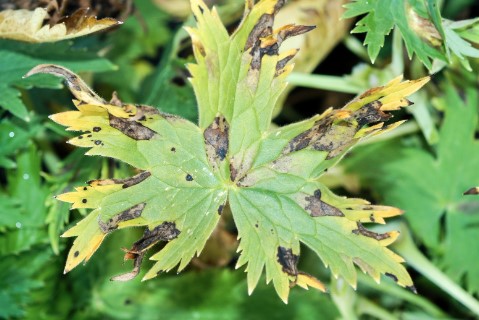
Downy mildew on Delphinium
Downy mildew on hebe (Hebe species) caused by Peronospora grisea. (BELOW). The disease is usually noticed first by a yellowish discoloration often with purple halos on the lower leaves of the plants. Leaves become curled and distorted. A grayish- brown sporulation may develop on the underside of the leaves. Eventually the affected parts of leaves turn brown and shrivel. Plants can be entirely defoliated and killed.
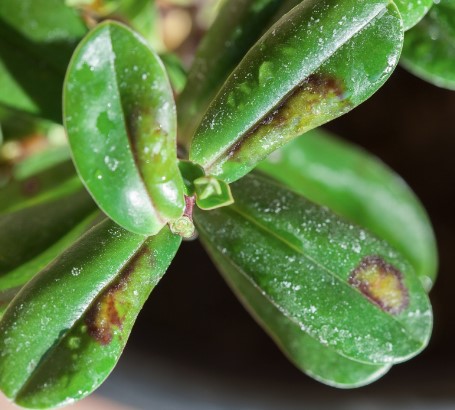
Downy mildew of Hebe
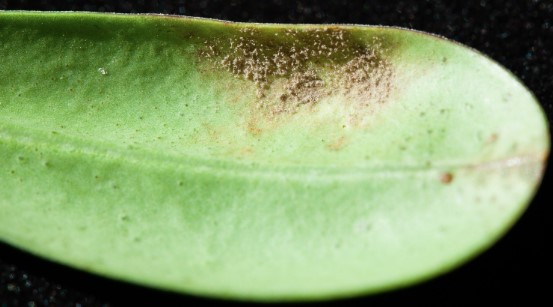
Sporulation of downy mildew on Hebe
Downy mildew on snapdragon (Antirrhinum majus) caused by Peronospora antirrhini. (BELOW) Young tip leaves are dull green, severely stunted, and roll downward. Gray-purple fungus grows on undersides of leaves. Disease is common on seedling phase; large plants are less frequently attacked. Infected plants fail to produce flowers.

Apparently healthy flat of snapdragon seedlings, except......
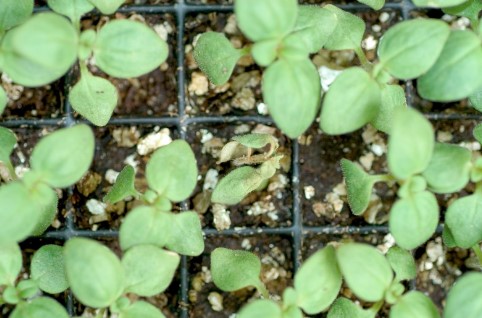
Downy mildew on snapdragon, closeup
Source:ucanr.edu